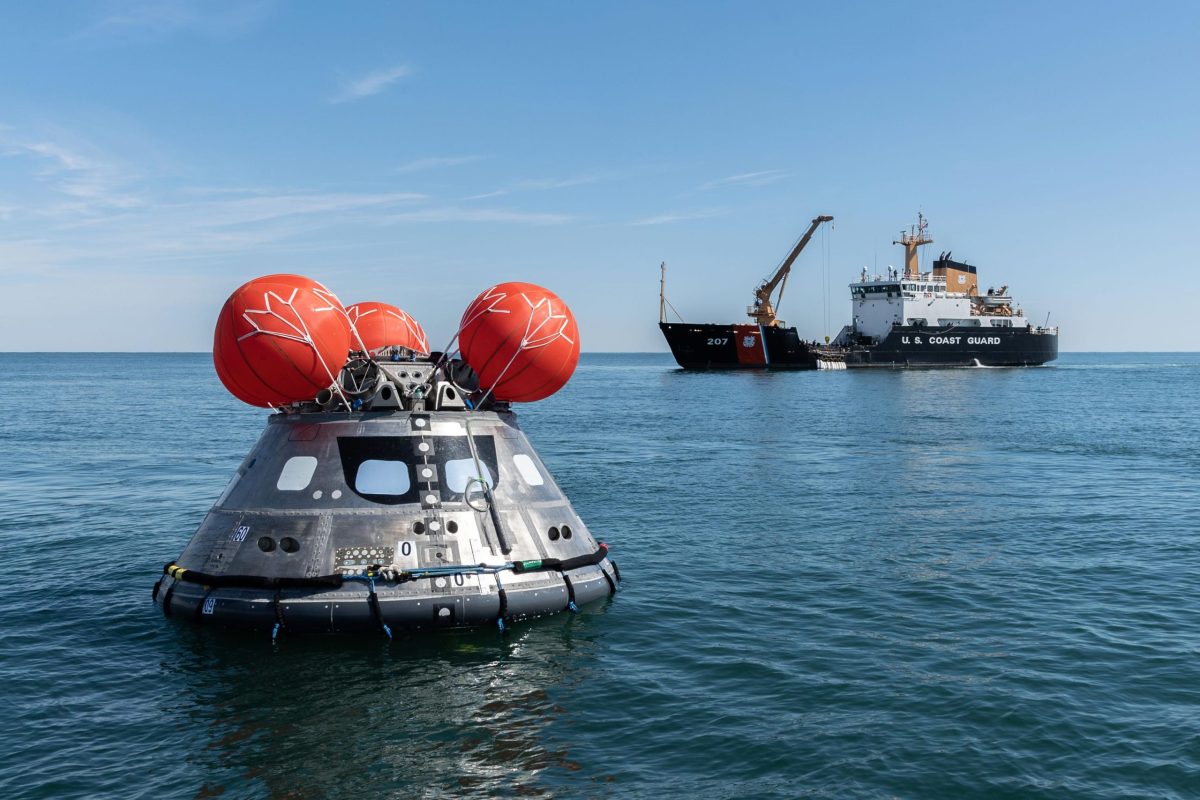NASA tested Orion’s crew module uprighting system off the Coast of North Carolina in March 2018. Credit: NASA
On flight day 23 of NASA’s Artemis I mission, the Orion spacecraft continues making the return trip to Earth, capturing photos and video along the way.
“At present, we are on track to have a fully successful mission with some bonus objectives that we’ve achieved along the way,” said Mike Sarafin, Artemis I mission manager. “On entry day, we will realize our priority one objective, which is to demonstrate the vehicle at lunar re-entry conditions, as well as our priority three objective, which is to retrieve the spacecraft.”
The mission management team met with the entry flight director and NASA recovery director as the planned splashdown of Orion Sunday, December 11 is now about 72 hours away. They evaluated the weather and decided on a landing site in the Pacific Ocean near Guadalupe Island, south of the primary landing area. Watch the reentry preview briefing (video embedded below) for more details.
On December 8, NASA experts will preview the upcoming entry, descent, and splashdown of the Orion spacecraft, which will conclude the Artemis I mission. After 25.5 days in space, Orion is expected to splash down in the Pacific Ocean off the coast of San Diego at 12:40 p.m. EST (17:40 UTC) on Sunday, Dec. 11. The exploration ground systems recovery team from NASA’s Kennedy Space Center in Florida, working with the U.S. Navy, will recover the spacecraft. Live coverage for this event begins at 11 a.m. EST (16:00 UTC).
Later last night, flight controllers conducted a final survey of Orion’s crew module and service module using cameras on each of the spacecraft’s four solar arrays. During the crew module inspection, flight controllers look at the back shell made up of 1,300 thermal protection system tiles which will protect the spacecraft from the cold of space and the extreme heat of re-entry.
Just before re-entry, the crew module and service module will separate and only the crew module will return to Earth while the service module burns up in Earth’s atmosphere upon re-entry over the Pacific Ocean. The Artemis I trajectory is designed to ensure any remaining parts do not pose a hazard to land, people, or shipping lanes.

The Moon appears smaller from Orion’s perspective on flight day 22 as the Artemis I spacecraft continues distancing itself from our lunar neighbor, over 125,000 miles away in this image. Credit: NASA
After separating from the service module, the crew module will prepare to perform a skip entry technique that enables the spacecraft to accurately and consistently splash down at the selected landing site. Orion will dip into the upper part of Earth’s atmosphere and use that atmosphere, along with the lift of the capsule, to skip back out of the atmosphere, then reenter for final descent under parachutes and splash down. This technique will allow a safe re-entry for future Artemis missions regardless of when and where they return from the Moon.
Earth’s atmosphere initially will slow the spacecraft to 325 mph (525 km/h), then the parachutes will slow Orion to a splashdown speed in about 10 minutes as it descends through Earth’s atmosphere. Parachute deployment begins at an altitude of about five miles with three small parachutes pulling the forward bay covers away. Once the forward bay cover separates, two drogue parachutes will slow and stabilize the crew module for main parachute deployment. At an altitude of 9,500 feet (2,900 meters) and a spacecraft speed of 130 mph (210 km/h), three pilot parachutes will lift and deploy the main parachutes. Those 116-foot-diameter (35-meter-diameter) parachutes of nylon broadcloth, or “silk,” will slow the Orion crew module to a splashdown speed of 20 mph (32 km/h) or less.

Orion continues its journey home to Earth, which appears here as a crescent, still 234,000 miles away. The Artemis I spacecraft is scheduled to splash down in the Pacific Ocean on Sunday, December 11.
The parachute system includes 11 parachutes made of 36,000 square feet (3,300 square meters) of canopy material. The canopy is attached to the top of the spacecraft with more than 13 miles of Kevlar lines that are deployed in series using cannon-like mortars and pyrotechnic thrusters and bolt cutters. Learn more about Orion’s parachute system in the Artemis I reference guide.
NASA TV coverage of Artemis I’s return to Earth begins at 11 a.m. EST on Sunday, December 11. The Orion spacecraft is scheduled to splash down in the Pacific Ocean at 12:40 p.m. near Guadalupe Island.
Just before 6:00 p.m. CST on December 8, Orion was traveling 207,200 miles (333,456 km) from Earth and 180,400 miles from the Moon, cruising at 1,415 mph (2,277 km/h).
Orion launched aboard the Space Launch System (SLS) rocket at 1:47 am EST (6:47 UTC) on November 16 from historic Launch Complex 39B at NASA’s Kennedy Space Center.
The Artemis I mission is the first integrated test of NASA’s deep space exploration systems: the Orion spacecraft, the SLS rocket, and Kennedy Space Center’s Exploration Ground Systems.
Share your story or advertise with us: Whatsapp: +2347068606071 Email: info@newspotng.com















